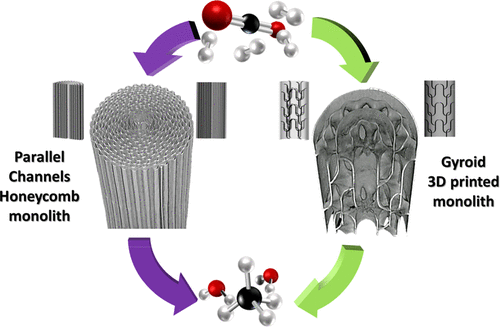当前位置:
X-MOL 学术
›
ACS Sustain. Chem. Eng.
›
论文详情
Our official English website, www.x-mol.net, welcomes your
feedback! (Note: you will need to create a separate account there.)
Stepping toward Efficient Microreactors for CO2 Methanation: 3D-Printed Gyroid Geometry
ACS Sustainable Chemistry & Engineering ( IF 7.1 ) Pub Date : 2021-06-08 , DOI: 10.1021/acssuschemeng.1c01980 Francisco M. Baena-Moreno 1, 2 , Miriam González-Castaño 1 , Juan Carlos Navarro de Miguel 3 , Kamal U. M. Miah 4 , Ralf Ossenbrink 4 , Jose Antonio Odriozola 3, 5 , Harvey Arellano-García 1, 5
ACS Sustainable Chemistry & Engineering ( IF 7.1 ) Pub Date : 2021-06-08 , DOI: 10.1021/acssuschemeng.1c01980 Francisco M. Baena-Moreno 1, 2 , Miriam González-Castaño 1 , Juan Carlos Navarro de Miguel 3 , Kamal U. M. Miah 4 , Ralf Ossenbrink 4 , Jose Antonio Odriozola 3, 5 , Harvey Arellano-García 1, 5
Affiliation

|
This work presents a comparative study toward the development of efficient microreactors based on three-dimensional (3D)-printed structures. Thus, the study evaluates the influence of the metal substrate geometry on the performance of structured catalysts for the CO2 methanation reaction. For this purpose, the 0.5%Ru–15%Ni/MgAl2O4 catalyst is washcoated over two different micromonolithic metal substrates: a conventional parallel channel honeycomb structure and a novel 3D-printed structure with a complex gyroid geometry. The effect of metal substrate geometry is analyzed for several CO2 sources including ideal flue gas atmospheres and the presence of residual CH4 and CO in the flue gas, as well as simulated biogas sources. The advantages of the gyroid 3D complex geometries over the honeycomb structures are shown for all evaluated conditions, providing in the best-case scenario a 14% improvement in CO2 conversion. Moreover, this contribution shows that systematically tailoring geometrical features of structured catalysts becomes an effective strategy to achieve improved catalyst performances independent of the flue gas composition. By enhancing the transport processes and the gas–catalyst interactions, the employed gyroid 3D metal substrates enable boosted CO2 conversions and greater CH4 selectivity within diffusion-controlled regimes.
中文翻译:

迈向用于 CO 2甲烷化的高效微反应器:3D 打印的陀螺几何
这项工作对基于三维 (3D) 打印结构的高效微反应器的开发进行了比较研究。因此,该研究评估了金属基材几何形状对用于 CO 2甲烷化反应的结构化催化剂性能的影响。为此,将 0.5%Ru–15%Ni/MgAl 2 O 4催化剂涂覆在两种不同的微单片金属基材上:传统的平行通道蜂窝结构和具有复杂陀螺几何形状的新型 3D 打印结构。分析了几种 CO 2源的金属基材几何形状的影响,包括理想的烟气气氛和残留 CH 4的存在和烟气中的 CO,以及模拟沼气源。在所有评估条件下都显示了 gyroid 3D 复杂几何形状相对于蜂窝结构的优势,在最佳情况下,CO 2转化率提高了 14% 。此外,这一贡献表明,系统地调整结构化催化剂的几何特征成为实现独立于烟道气成分的改进催化剂性能的有效策略。通过增强传输过程和气体-催化剂相互作用,所采用的 gyroid 3D 金属基材能够在扩散控制范围内提高 CO 2转化率和更大的 CH 4选择性。
更新日期:2021-06-21
中文翻译:

迈向用于 CO 2甲烷化的高效微反应器:3D 打印的陀螺几何
这项工作对基于三维 (3D) 打印结构的高效微反应器的开发进行了比较研究。因此,该研究评估了金属基材几何形状对用于 CO 2甲烷化反应的结构化催化剂性能的影响。为此,将 0.5%Ru–15%Ni/MgAl 2 O 4催化剂涂覆在两种不同的微单片金属基材上:传统的平行通道蜂窝结构和具有复杂陀螺几何形状的新型 3D 打印结构。分析了几种 CO 2源的金属基材几何形状的影响,包括理想的烟气气氛和残留 CH 4的存在和烟气中的 CO,以及模拟沼气源。在所有评估条件下都显示了 gyroid 3D 复杂几何形状相对于蜂窝结构的优势,在最佳情况下,CO 2转化率提高了 14% 。此外,这一贡献表明,系统地调整结构化催化剂的几何特征成为实现独立于烟道气成分的改进催化剂性能的有效策略。通过增强传输过程和气体-催化剂相互作用,所采用的 gyroid 3D 金属基材能够在扩散控制范围内提高 CO 2转化率和更大的 CH 4选择性。











































 京公网安备 11010802027423号
京公网安备 11010802027423号